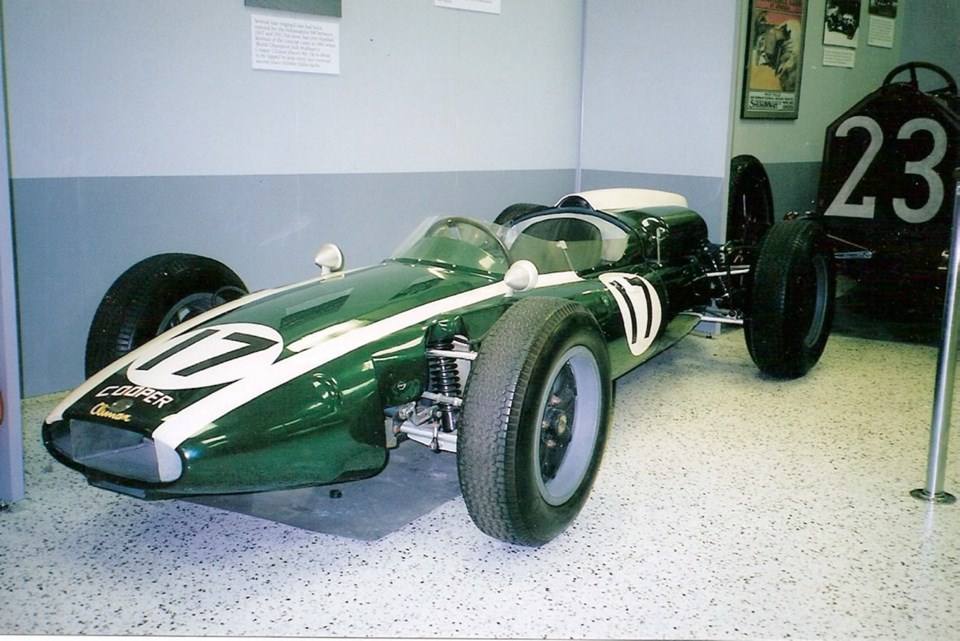The Indianapolis 500, called by many ŌĆ£The Greatest Spectacle in Racing,ŌĆØ started in 1911. For the first 50 years ŌĆö except for an occasional aberration such as unsuccessful 1930s and ŌĆÖ40s rear-engine racers ŌĆö the carsŌĆÖ basic front-engine, rear-drive layout remained intact. That began to change in 1961, and in just four years, the rear-engine conversion was virtually complete.
Rear-engine racers had competed in top-level European Grand Prix racing in the 1930s. Ferdinand Porsche, of Volkswagen fame, designed a rear-engine racer for GermanyŌĆÖs Auto Union, and in the hands of skilled drivers those fearsomely fast 12- and 16-cylinder Auto Unions enabled it, along with Mercedes-Benz, to dominate Grand Prix racing from 1934 to 1939.
Racing gradually revived after the Second World War. The Auto Union cars were gone, and with the establishment of the Formula 1 Grand Prix world driving championship in 1950, competitors ran front-engine cars.
Meanwhile, in 1946 in the London suburb of Surbiton, John Cooper began experimenting with tiny cars using 500-cc single-cylinder motorcycle engines behind the driver. Good power-to-weight ratios made them surprisingly fast in the 500-cc and Formula 3 classes.
With no driveshaft, the rear-engined cars were smaller and lighter. Low seating reduced frontal area, and famous drivers such as Stirling Moss learned their craft on Coopers.
CooperŌĆÖs rear-engine cars advanced to Formula 1 by 1957, and although his Coventry Climax 2.0-litre four gave away half a litre of displacement to competitors, Cooper won its first Grand Prix race in 1958.
The writing was on the wall for front-engine cars, and in 1959 and ŌĆÖ60, now with a full 2.5 litres, Coopers scored 13 victories, making Australian driver Jack Brabham the world driving champion both years. The rear-engine revolution had begun, and others, such as Lotus and BRM, quickly converted.
In October 1960, John Cooper brought Brabham and a championship Cooper to Indianapolis for testing. The conservative Indy racing establishment was skeptical that small, light, rear-engine cars could compete with their traditional big, rugged, Offenhauser-engine roadsters.
In spite of having only 2.5 litres compared with OffyŌĆÖs 4.2, Brabham took the little Cooper around at an easy 144.8 mph (233 km/h). Its light weight, more-sophisticated suspension and central weight bias made it quicker in corners. The front-row qualifiers for the 1960 race had run about 146 mph (235┬Ākm/h), so the Cooper demonstrated it could be competitive. Eyebrows began rising along Gasoline Alley.
Encouraged by its demonstration, and enticed by huge Indy purses, Cooper entered Brabham and a Cooper in the 1961 Indy. He enlarged the engine to 2.8 litres, tilted it to the left and added some left-side fuel tanks for even better cornering.
The Cooper ran well, qualified on the fifth row, and finished a commendable ninth. Its weakness was the Dunlop tires Cooper was under contract to use. BrabhamŌĆÖs tires wore out faster than the roadstersŌĆÖ Firestones, requiring more pit stops. They would last longer when running slower, meaning a lower-place finish, but the Indy revolution had begun.
Rear engines were back for 1962, but not from Cooper. California hotrodder Mickey Thompson saw the potential and constructed rear-engine racers with modified Buick aluminum V-8s. Driver Dan Gurney had mechanical problems and covered 93 laps, finishing 20th. Offenhauser-powered roadsters still ruled.
In 1963, Englishman Colin Chapman entered Scottish Formula 1 star Jim Clark and American Dan Gurney in rear-engine Lotus-Fords with modified Ford Fairlane V-8 engines. Mickey ThompsonŌĆÖs rear-engine design was also back, now Chevrolet-powered.
Clark finished second, only 34 seconds behind Parnelli JonesŌĆÖs front-engined Indy roadster, but it was a controversial victory. JonesŌĆÖ car began spewing oil onto the track late in the race, sparking a heated controversy. In spite of ChapmanŌĆÖs vociferous argument that Jones should be black-flagged, tradition dies hard at Indy and he was allowed to continue. Clark could pull to within 4.5 seconds of Jones, but had to back off on the slippery track.
Chapman was back for 1964 with rear-engine Lotuses, now with aluminum, twin-overhead-cam, 32-valve racing Ford V-8s. Although Clark set the official track record at 159.38 mph (257 km/h), Dunlop tires again let the Lotuses down. Clark and Gurney both retired early, but Roger Ward reinforced the new waveŌĆÖs threat by placing second in a Ford-powered rear-engine car.
In 1965, it became obvious that the reign of the Offenhauser-powered front-engine Indy roadster was ending. Only six of the 33 starters had front engines. Rear-engine Fords dominated and rear engines took the first four places, with Lotus Fords 1-2. Jim Clark and Lotus (on Firestones) finally won Indianapolis and relegated the outmoded Indy roadster to history.



